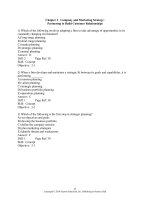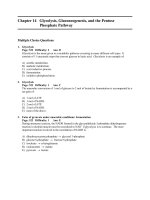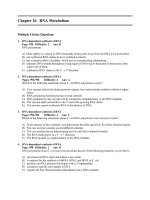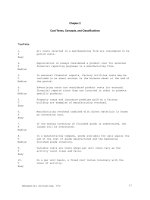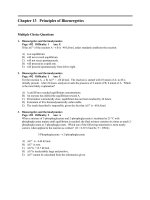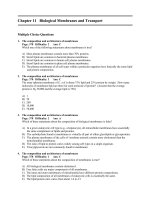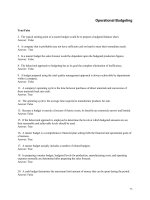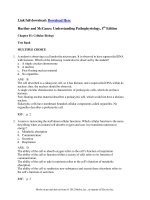kupdf com test 3 test bank physics 2
Bạn đang xem bản rút gọn của tài liệu. Xem và tải ngay bản đầy đủ của tài liệu tại đây (1.02 MB, 70 trang )
Chapter 28:
MAGNETIC FIELDS
1. Units of a magnetic field might be:
A. C·m/s
B. C·s/m
C. C/kg
D. kg/C·s
E. N/C·m
ans: D
2. In the formula F = qv × B:
A. F must be perpendicular to v but not necessarily to B
B. F must be perpendicular to B but not necessarily to v
C. v must be perpendicular to B but not necessarily to F
D. all three vectors must be mutually perpendicular
E. F must be perpendicular to both v and B
ans: E
3. An electron moves in the negative x direction, through a uniform magnetic field in the negative
y direction. The magnetic force on the electron is:
y
..
...
..
...
...
...
...
.
...
...
....
...
....
...
....
... .......
... .....
..
......................................................................................................................................
.. ...
.
.
.
.. ...
.
.
.
..
....
....
....
....
....
..
...
.
.
.
...
..
.
.
....
.
..
.
.
..
.
..
.
.
.
...
....
....
..
..
v
...........................•...
...
.
........
. B
x
z
A.
B.
C.
D.
E.
4. At
A.
B.
C.
D.
E.
in the negative x direction
in the positive y direction
in the negative y direction
in the positive z direction
in the negative z direction
ans: E
any point the magnetic field lines are in the direction of:
the magnetic force on a moving positive charge
the magnetic force on a moving negative charge
the velocity of a moving positive charge
the velocity of a moving negative charge
none of the above
ans: E
Chapter 28:
MAGNETIC FIELDS
405
5. The magnetic force on a charged particle is in the direction of its velocity if:
A. it is moving in the direction of the field
B. it is moving opposite to the direction of the field
C. it is moving perpendicular to the field
D. it is moving in some other direction
E. never
ans: E
6. A magnetic field exerts a force on a charged particle:
A. always
B. never
C. if the particle is moving across the field lines
D. if the particle is moving along the field lines
E. if the particle is at rest
ans: C
7. The direction of the magnetic field in a certain region of space is determined by firing a test
charge into the region with its velocity in various directions in di erent trials. The field direction
is:
A. one of the directions of the velocity when the magnetic force is zero
B. the direction of the velocity when the magnetic force is a maximum
C. the direction of the magnetic force
D. perpendicular to the velocity when the magnetic force is zero
E. none of the above
ans: A
8. An electron is moving north in a region where the magnetic field is south. The magnetic force
exerted on the electron is:
A. zero
B. up
C. down
D. east
E. west
ans: A
9. A magnetic field CANNOT:
A. exert a force on a charged particle
B. change the velocity of a charged particle
C. change the momentum of a charged particle
D. change the kinetic energy of a charged particle
E. change the trajectory of a charged particle
ans: D
406
Chapter 28:
MAGNETIC FIELDS
10. A proton (charge e), traveling perpendicular to a magnetic field, experiences the same force as
an alpha particle (charge 2e) which is also traveling perpendicular to the same field. The ratio
of their speeds, vproton /valpha , is:
A. 0.5
B. 1
C. 2
D. 4
E. 8
ans: C
11. A hydrogen atom that has lost its electron is moving east in a region where the magnetic field
is directed from south to north. It will be deflected:
A. up
B. down
C. north
D. south
E. not at all
ans: A
12. A beam of electrons is sent horizontally down the axis of a tube to strike a fluorescent screen
at the end of the tube. On the way, the electrons encounter a magnetic field directed vertically
downward. The spot on the screen will therefore be deflected:
A. upward
B. downward
C. to the right as seen from the electron source
D. to the left as seen from the electron source
E. not at all
ans: C
13. An electron (charge = 1.6 × 10 19 C) is moving at 3 × 105 m/s in the positive x direction. A
magnetic field of 0.8 T is in the positive z direction. The magnetic force on the electron is:
A. 0
B. 4 × 10 14 N, in the positive z direction
C. 4 × 10 14 N, in the negative z direction
D. 4 × 10 14 N, in the positive y direction
E. 4 × 10 14 N, in the negative y direction
ans: D
14. At one instant an electron (charge = 1.6×10 19 C) is moving in the xy plane, the components
of its velocity being vx = 5 × 105 m/s and vy = 3 × 105 m/s. A magnetic field of 0.8 T is in the
positive x direction. At that instant the magnitude of the magnetic force on the electron is:
A. 0
B. 2.6 × 10 14 N
C. 3.8 × 10 14 N
D. 6.4 × 10 14 N
E. 1.0 × 10 13 N
ans: C
Chapter 28:
MAGNETIC FIELDS
407
15. At one instant an electron (charge = 1.6×10 19 C) is moving in the xy plane, the components
of its velocity being vx = 5 × 105 m/s and vy = 3 × 105 m/s. A magnetic field of 0.8 T is in the
positive x direction. At that instant the magnitude of the magnetic force on the electron is:
A. 0
B. 3.8 × 10 14 N
C. 5.1 × 10 14 N
D. 6.4 × 10 14 N
E. 7.5 × 10 14 N
ans: B
16. An electron travels due north through a vacuum in a region of uniform magnetic field B that
is also directed due north. It will:
A. be una ected by the field
B. speed up
C. slow down
D. follow a right-handed corkscrew path
E. follow a left-handed corkscrew path
ans: A
17. At one instant an electron is moving in the positive x direction along the x axis in a region
where there is a uniform magnetic field in the positive z direction. When viewed from a point
on the positive z axis, it subsequent motion is:
A. straight ahead
B. counterclockwise around a circle in the xy plane
C. clockwise around a circle in the xy plane
D. in the positive z direction
E. in the negative z direction
ans: B
18. A uniform magnetic field is directed into the page. A charged particle, moving in the plane of
the page, follows a clockwise spiral of decreasing radius as shown. A reasonable explanation is:
particle
.................................
.........
....... .
.......
...... ..
......
............................... ...................
....
.
.
.
.
.
.
.
.
......
..
... ..........
.... ......
.
.
.
.
...
.
.
.
.
.
.
..
.
.
.
.
.
..
..
.
.
.
.
.
.
.
.
.
.
.....
...
... ..... ....
...
...
.....
.... .... .... ................ .... .... ....
...
... ...
...
... ... ... ...
.
.
.
.
...
..
..
.. .... .... ....
.. .... ....
.
....
... ....
..
...
...
.
.
.
.
.
....................
.
...
.
...
.
.
.
.
.
.
..
.
... .........
..... ....
...
...............................
...
.....
.....
......
......
.
.......
.
.
.
.
.
.............................
•
B
A.
B.
C.
D.
E.
408
the charge is positive and slowing down
the charge is negative and slowing down
the charge is positive and speeding up
the charge is negative and speeding up
none of the above
ans: B
Chapter 28:
MAGNETIC FIELDS
19. An electron and a proton each travel with equal speeds around circular orbits in the same
uniform magnetic field, as shown in the diagram (not to scale). The field is into the page on
the diagram. Because the electron is less massive than the proton and because the electron is
negatively charged and the proton is positively charged:
•
•
.....................
.........
......
.....
...
....
...
..
...
.
...
.....
..
...
...
...
...
..
.
.
...
.
.
...
.
.
.
.
.....
.......
.....
............................
B
..............................
...............
.........
........
.......
.......
......
......
.....
.
.
.
.
....
....
.
....
.
..
.
...
.
..
...
.
.
...
...
.
...
..
...
.
...
....
..
...
..
..
...
..
..
...
..
...
..
.
...
....
...
...
...
.
...
..
...
...
...
...
...
...
...
.
....
..
....
...
......
.....
......
......
.......
......
.
.
.
.
.
..........
.
.
..........................................
A. the electron travels clockwise around the smaller circle and the proton travels counterclockwise around the larger circle
B. the electron travels counterclockwise around the smaller circle and the proton travels clockwise around the larger circle
C. the electron travels clockwise around the larger circle and the proton travels counterclockwise around the smaller circle
D. the electron travels counterclockwise around the larger circle and the proton travels clockwise around the smaller circle
E. the electron travels counterclockwise around the smaller circle and the proton travels counterclockwise around the larger circle
ans: A
20. An electron is launched with velocity v in a uniform magnetic field B. The angle between
v and B is between 0 and 90 . As a result, the electron follows a helix, its velocity vector v
returning to its initial value in a time interval of:
A. 2 m/eB
B. 2 mv/eB
C. 2 mv sin /eB
D. 2 mv cos /eB
E. none of these
ans: A
21. An electron and a proton are both initially moving with the same speed and in the same
direction at 90 to the same uniform magnetic field. They experience magnetic forces, which
are initially:
A. identical
B. equal in magnitude but opposite in direction
C. in the same direction and di ering in magnitude by a factor of 1840
D. in opposite directions and di ering in magnitude by a factor of 1840
E. equal in magnitude but perpendicular to each other.
ans: B
Chapter 28:
MAGNETIC FIELDS
409
22. An electron enters a region of uniform perpendicular E and B fields. It is observed that the
velocity v of the electron is una ected. A possible explanation is:
A. v is parallel to E and has magnitude E/B
B. v is parallel to B
C. v is perpendicular to both E and B and has magnitude B/E
D. v is perpendicular to both E and B and has magnitude E/B
E. the given situation is impossible
ans: D
23. A charged particle is projected into a region of uniform, parallel, E and B fields. The force on
the particle is:
A. zero
B. at some angle < 90 with the field lines
C. along the field lines
D. perpendicular to the field lines
E. unknown (need to know the sign of the charge)
ans: B
24. A uniform magnetic field is in the positive z direction. A positively charged particle is moving
in the positive x direction through the field. The net force on the particle can be made zero
by applying an electric field in what direction?
A. Positive y
B. Negative y
C. Positive x
D. Negative x
E. Positive z
ans: B
25. An electron is traveling in the positive x direction. A uniform electric field E is in the negative
y direction. If a uniform magnetic field with the appropriate magnitude and direction also
exists in the region, the total force on the electron will be zero. The appropriate direction for
the magnetic field is:
y
v
•..........................
.
........
.E
A.
B.
C.
D.
E.
410
the positive y direction
the negative y direction
into the page
out of the page
the negative x direction
ans: C
Chapter 28:
MAGNETIC FIELDS
x
26. An ion with a charge of +3.2×10 19 C is in a region where a uniform electric field of 5×104 V/m
is perpendicular to a uniform magnetic field of 0.8 T. If its acceleration is zero then its speed
must be:
A. 0
B. 1.6 × 104 m/s
C. 4.0 × 104 m/s
D. 6.3 × 104 m/s
E. any value but 0
ans: D
27. The current is from left to right in the conductor shown. The magnetic field is into the page
and point S is at a higher potential than point T. The charge carriers are:
S
•
.....
...........................................................................
....
i
•
T
A.
B.
C.
D.
E.
positive
negative
neutral
absent
moving near the speed of light
ans: A
28. Electrons (mass m, charge e) are accelerated from rest through a potential di erence V and
are then deflected by a magnetic field B that is perpendicular to their velocity. The radius of
the resulting electron trajectory is:
A. ( 2eV /m)/B
B. B 2eV /m
C. ( 2mV /e)/B
D. B 2mV /e
E. none of these
ans: C
29. In a certain mass spectrometer, an ion beam passes through a velocity filter consisting of
mutually perpendicular fields E and B. The beam then enters a region of another magnetic
field B perpendicular to the beam. The radius of curvature of the resulting ion beam is
proportional to:
A. EB /B
B. EB/B
C. BB /E
D. B/EB
E. E/BB
ans: E
Chapter 28:
MAGNETIC FIELDS
411
30. A cyclotron operates with a given magnetic field and at a given frequency. If R denotes the
radius of the final orbit, the final particle energy is proportional to:
A. 1/R
B. R
C. R2
D. R3
E. R4
ans: C
31. J. J. Thomson’s experiment, involving the motion of an electron beam in mutually perpendicular E and B fields, gave the value of:
A. mass of an electron
B. charge of an electron
C. Earth’s magnetic field
D. charge/mass ratio for electrons
E. Avogadro’s number
ans: D
32. The diagram shows a straight wire carrying a flow of electrons into the page. The wire is
between the poles of a permanent magnet. The direction of the magnetic force exerted on the
wire is:
N
A.
B.
C.
D.
E. into the page
ans: A
412
Chapter 28:
MAGNETIC FIELDS
....
...... .......
..
.....
.... .....
.........
S
33. The figure shows the motion of electrons in a wire that is near the N pole of a magnet. The
wire will be pushed:
...
...
...
...
...
...
...
...
...
...
...
...
...
...
...
...
...
...
...
...
...
...
...
...
...
...
...
...
•••
...
...
...
•
...
•
...
•
...
•
•
•
•
•
...
•
•
•
...
•
•
•
•
•
•
•
...
•
•
•
...
••• •••••••••••
...
...
••• ••••••• .....................
...
...
...
..
...
•
.
.
.
.
•
.
.... ......
.
.
...
...
•••
..
...
...
.......
.............. ...
...
.
...
.......
.
...
....... .........
.......
...
.
.
.
.
.
.
.
.
.
.
.
.
...
...
...
.... ...........
.
.
.
.
.
.
.
.
.
.
...
.
.
... ......
.... .............
.
.
.
...
.
...........
.
.
... ......... ..
...
...
.......
..
.
...
...... . ......
....
...
...
...................... .......
.
...
... .........................................
...
.
.
...
.
. ...... .. .......
.
.
.
.
...
.
.......
....
.
.
.
.
.
.
.
.
.
.
.
.
.
.
... ........
....
....
.
.
.
.
.
.
.
.
.
.
.........
.
.
.
..
...
.......
.......
....... ................
.......
........
...
.......
..... .... ............ .... ....
.......
... .. ............
.........
...... ........
....
A.
B.
C.
D.
E.
electron
flow
toward the magnet
away from the magnet
downwards
upwards
along its length
ans: D
34. The diagram shows a straight wire carrying current i in a uniform magnetic field. The magnetic
force on the wire is indicated by an arrow but the magnetic field is not shown. Of the following
possibilities, the direction of the magnetic field is:
i
..
.......................................................................
..
...
...
...
...
...
...
...
.
..........
.......
...
A.
B.
C.
D.
E.
F
opposite the direction of the current
opposite the direction of F
in the direction of F
into the page
out of the page
ans: E
Chapter 28:
MAGNETIC FIELDS
413
35. The figure shows a uniform magnetic field B directed to the left and a wire carrying a current
into the page. The magnetic force acting on the wire is:
....
...................................................................................................................................................................................................................
....
....
...................................................................................................................................................................................................................
....
B
i
....
...................................................................................................................................................................................................................
....
....
...................................................................................................................................................................................................................
....
A.
B.
C.
D.
E.
toward
toward
toward
toward
zero
ans: A
the
the
the
the
top of the page
bottom of the page
left
right
36. A loop of wire carrying a current of 2.0 A is in the shape of a right triangle with two equal sides,
each 15 cm long. A 0.7 T uniform magnetic field is parallel to the hypotenuse. The resultant
magnetic force on the two equal sides has a magnitude of:
A. 0
B. 0.21 N
C. 0.30 N
D. 0.41 N
E. 0.51 N
ans: A
37. A loop of wire carrying a current of 2.0 A is in the shape of a right triangle with two equal
sides, each 15 cm long. A 0.7 T uniform magnetic field is in the plane of the triangle and is
perpendicular to the hypotenuse. The magnetic force on either of the two equal sides has a
magnitude of:
A. zero
B. 0.105 N
C. 0.15 N
D. 0.21 N
E. 0.25 N
ans: C
38. A current is clockwise around the outside edge of this page and a uniform magnetic field is
directed parallel to the page, from left to right. If the magnetic force is the only force acting
on the page, the page will turn so the right edge:
A. moves toward you
B. moves away from you
C. moves to your right
D. moves to your left
E. does not move
ans: A
414
Chapter 28:
MAGNETIC FIELDS
39. A square loop of wire lies in the plane of the page and carries a current I as shown. There is a
uniform magnetic field B parallel to the side MK as indicated. The loop will tend to rotate:
R
.
.
K .......................................................................................... L
...
...
...
...
..
..
..
..
.
..
..
.. B ....
...
..
..
..
...
..
..
..
... Q
..
..
P ...
..
..
..
..
..
.. .........
....
.... I
..
..
I .....
...
..
..
..
.
..
..
..
................................................................................
.
.
M
N
.
.
S
A.
B.
C.
D.
E.
about PQ with KL coming out of the page
about PQ with KL going into the page
about RS with MK coming out of the page
about RS with MK going into the page
about an axis perpendicular to the page.
ans: A
40. The units of magnetic dipole moment are:
A. ampere
B. ampere·meter
C. ampere·meter2
D. ampere/meter
E. ampere/meter2
ans: C
41. You are facing a loop of wire which carries a clockwise current of 3.0 A and which surrounds
an area of 5.8 × 10 2 m2 . The magnetic dipole moment of the loop is:
A. 3.0 A · m2 , away from you
B. 3.0 A · m2 , toward you
C. 0.17 A · m2 , away from you
D. 0.17 A · m2 , toward you
E. 0.17 A · m2 , left to right
ans: C
42. The magnetic torque exerted on a flat current-carrying loop of wire by a uniform magnetic
field B is:
A. maximum when the plane of the loop is perpendicular to B
B. maximum when the plane of the loop is parallel to B
C. dependent on the shape of the loop for a fixed loop area
D. independent of the orientation of the loop
E. such as to rotate the loop around the magnetic field lines
ans: B
Chapter 28:
MAGNETIC FIELDS
415
43. A circular loop of wire with a radius of 20 cm lies in the xy plane and carries a current of 2 A,
counterclockwise when viewed from a point on the positive z axis. Its magnetic dipole moment
is:
A. 0.25 A · m2 , in the positive z direction
B. 0.25 A · m2 , in the negative z direction
C. 2.5 A · m2 , in the positive z direction
D. 2.5 A · m2 , in the negative z direction
E. 0.25 A · m2 , in the xy plane
ans: A
44. The diagrams show five possible orientations of a magnetic dipole µ in a uniform magnetic field
B. For which of these does the magnetic torque on the dipole have the greatest magnitude?
. µ
....... .......
........................................
................................................ B
..
A
µ
.............................
..
........................................................................................
..
B
µ .........
..
.....
....
..
........................................................................................
..
B
B
C
........ µ
......
.....
..
..
........................................................................................
..
B
D
µ
............................
..
........................................................................................
..
B
E
ans: A
45. The magnetic dipole moment of a current-carrying loop of wire is in the positive z direction.
If a uniform magnetic field is in the positive x direction the magnetic torque on the loop is:
A. 0
B. in the positive y direction
C. in the negative y direction
D. in the positive z direction
E. in the negative z direction
ans: B
46. For a loop of current-carrying wire in a uniform magnetic field the potential energy is a minimum
if the magnetic dipole moment of the loop is:
A. in the same direction as the field
B. in the direction opposite to that of the field
C. perpendicular to the field
D. at an angle of 45 to the field
E. none of the above
ans: A
47. The diagrams show five possible orientations of a magnetic dipole µ in a uniform magnetic field
B. For which of these is the potential energy the greatest?
. µ
...... ........
........................................
............................................... B
..
A
µ
.............................
..
........................................................................................
..
B
B
ans: E
416
Chapter 28:
µ .........
..
.....
....
..
........................................................................................
..
MAGNETIC FIELDS
C
B
........ µ
......
.....
..
..
........................................................................................
..
D
B
µ
............................
..
........................................................................................
..
E
B
48. A loop of current-carrying wire has a magnetic dipole moment of 5 × 10 4 A · m2 . The moment
initially is aligned with a 0.5-T magnetic field. To rotate the loop so its dipole moment is
perpendicular to the field and hold it in that orientation, you must do work of:
A. 0
B. 2.5 × 10 4 J
C.
2.5 × 10 4 J
D. 1.0 × 10 3 J
E.
1.0 × 10 3 J
ans: B
Chapter 28:
MAGNETIC FIELDS
417
Chapter 29:
MAGNETIC FIELDS DUE TO CURRENTS
1. Suitable units for µ0 are:
A. tesla
B. newton/ampere2
C. weber/meter
D. kilogram·ampere/meter
E. tesla·meter/ampere
ans: E
2. A “coulomb” is:
A. one ampere per second
B. the quantity of charge that will exert a force of 1 N on a similar charge at a distance of 1 m
C. the amount of current in each of two long parallel wires, separated by 1 m, that produces
a force of 2 × 10 7 N/m
D. the amount of charge that flows past a point in one second when the current is 1 A
E. an abbreviation for a certain combination of kilogram, meter and second
ans: D
3. Electrons are going around a circle in a counterclockwise direction as shown. At the center of
the circle they produce a magnetic field that is:
..........
................ ...........................
.......
......
......
....
.
.
.
.
.
...
...
....
...
...
.
...
..
.
..
...
....
...
..............
.....
....
.
... ....
...
...........
..
...
...
...
..
.
.
...
.
...
...
....
...
.....
....
......
......
.
.
.
........
.
.
........................................
A.
B.
C.
D.
E.
418
electron
into the page
out of the page
to the left
to the right
zero
ans: A
Chapter 29:
MAGNETIC FIELDS DUE TO CURRENTS
4. In the figure, the current element i d , the point P, and the three vectors (1, 2, 3) are all in the
plane of the page. The direction of dB, due to this current element, at the point P is:
3...
..
....
.......
..........
..
...
..
.
...
...
....
.
...
..................
...
... ..
.
.
...
.
.
...
....
....
...
...
...
....
...
.
...
.
.
...
....
...
...
...
...
....
...
.
...
.
... .......
.... .....
..
.................................................................................................................
..
i
................................................ ......
... ...
...
...
.... ....
.......................................
.
.
.
..
.
... ................................................... .....
d
2
•
P
A.
B.
C.
D.
E.
1
in the direction marked “1”
in the direction marked “2”
in the direction marked “3”
out of the page
into the page
ans: E
5. The magnitude of the magnetic field at point P, at the center of the semicircle shown, is given
by:
.. i
...................................
.
.
.
.
.
.
.....
...
...
..........
...
.. . ..............
...
...
....
..
....
.. ..
........................................ R ....•...
....................................
P
A.
B.
C.
D.
E.
2µ0 i/R
µ0 i/R
µ0 i/4 R
µ0 i/2R
µ0 i/4R
ans: E
Chapter 29:
MAGNETIC FIELDS DUE TO CURRENTS
419
6. The diagrams show three circuits consisting of concentric circular arcs (either half or quarter
circles of radii r, 2r, and 3r) and radial lengths. The circuits carry the same current. Rank
them according to the magnitudes of the magnetic fields they produce at C, least to greatest.
..............................
............
.......
.......
......
......
.....
.....
.....
.
.
.
....
...
.
.
...
...
...
.
.
...
.
.
.
...
....
...
...
...
...
..
..
...
..................................... ...
.................................................. ..
.
...
.
.
.
...
.
.
.
.....
........................
1
C
•
A.
B.
C.
D.
E.
..............................
............
.......
.......
......
......
.....
.....
.....
.
.
.
....
...
.
.
...
...
...
.
.
...
.
.
.
...
....
...
........................
.
.
.
...
.
...
...
...
.
.
...
..
...
..
...
....
..
..................................... .
................................................. ..
2
•
C
..............................
............
.......
.......
......
......
.....
.....
.....
.
.
.
....
.....
.
.
.
.
.
...
.
.
.
.
.
.
.
.
.
.
...
..
......
.
...
.
...
.
.
.
.
.
...
....
...
.
.
.
.
.
...
..
...
.
.
.
....
.........
.
...
.....
...
....
...
...
...
...
..
...
...
...
....................................... ....
....................
3
•
C
1, 2, 3
3, 2, 1
1, 3, 2
2, 3, 1
2, 1, 3
ans: B
7. Lines of the magnetic field produced by a long straight wire carrying a current are:
A. in the direction of the current
B. opposite to the direction of the current
C. radially outward from the wire
D. radially inward toward the wire
E. circles that are concentric with the wire
ans: E
8. In an overhead straight wire, the current is north. The magnetic field due to this current, at
our point of observation, is:
A. east
B. up
C. north
D. down
E. west
ans: E
9. A wire carrying a large current i from east to west is placed over an ordinary magnetic compass.
The end of the compass needle marked “N” will point:
A. north
B. south
C. east
D. west
E. the compass will act as an electric motor, hence the needle will keep rotating
ans: B
420
Chapter 29:
MAGNETIC FIELDS DUE TO CURRENTS
10. The magnetic field outside a long straight current-carrying wire depends on the distance R
from the wire axis according to:
A. R
B. 1/R
C. 1/R2
D. 1/R3
E. 1/R3/2
ans: B
11. Which graph correctly gives the magnitude of the magnetic field outside an infinitely long
straight current-carrying wire as a function of the distance r from the wire?
B
B
.
..
.
..
...
.
.
..
....
.
.
.
.
.
...........
r
A
B.
...
...
...
....
....
.....
......
..........
D
B
..
....
.
.
...
.....
.
.
.
...
.....
.
.
.
.
...
r
B
r
..........
......
.
.
.
...
...
.
.
...
..
.
.
r
C
B ..
.....
.....
.....
.....
.....
.....
.....
..
r
E
ans: D
12. The magnetic field a distance 2 cm from a long straight current-carrying wire is 2.0 × 10
The current in the wire is:
A. 0.16 A
B. 1.0 A
C. 2.0 A
D. 4.0 A
E. 25 A
ans: C
5
T.
13. Two long parallel straight wires carry equal currents in opposite directions. At a point midway
between the wires, the magnetic field they produce is:
A. zero
B. non-zero and along a line connecting the wires
C. non-zero and parallel to the wires
D. non-zero and perpendicular to the plane of the two wires
E. none of the above
ans: D
Chapter 29:
MAGNETIC FIELDS DUE TO CURRENTS
421
14. Two long straight wires are parallel and carry current in the same direction. The currents are
8.0 and 12 A and the wires are separated by 0.40 cm. The magnetic field in tesla at a point
midway between the wires is:
A. 0
B. 4.0 × 10 4
C. 8.0 × 10 4
D. 12 × 10 4
E. 20 × 10 4
ans: B
15. Two long straight wires are parallel and carry current in opposite directions. The currents are
8.0 and 12 A and the wires are separated by 0.40 cm. The magnetic field in tesla at a point
midway between the wires is:
A. 0
B. 4.0 × 10 4
C. 8.0 × 10 4
D. 12 × 10 4
E. 20 × 10 4
ans: E
16. Two long straight current-carrying parallel wires cross the x axis and carry currents I and 3I
in the same direction, as shown. At what value of x is the net magnetic field zero?
x
0
1
3
.
......
........
....
A.
B.
C.
D.
E.
422
I
4
5
7
.
......
........
....
3I
0
1
3
5
7
ans: C
Chapter 29:
MAGNETIC FIELDS DUE TO CURRENTS
17. Two long straight wires pierce the plane of the paper at vertices of an equilateral triangle as
shown below. They each carry 2 A, out of the paper. The magnetic field at the third vertex
(P) has magnitude (in T):
P
....
... ...
... ....
...
...
.
...
...
...
..
...
...
.
...
.
...
...
.
...
..
.
...
.
.
...
.
..
...
.
.
...
...
.
...
.
.
.
...
...
...
.
.
...
.
.
.•
..
.•
.
•
•
•
•
.•
•
•
•
•
•
•
.
•
•
•
•
.•
•
•
•
•
•
•
•
•
•
•
•
•
•
..•
.•
•
•
•
•
•
•
•
•
•
•
.•
.•
..•
......................................................................................•
•
•
•
•
•
•
•
•
•
•
•
•
•
4 cm
2 A •••••••••••••••••••••••
A.
B.
C.
D.
E.
1.0 × 10
1.7 × 10
2.0 × 10
5.0 × 10
8.7 × 10
ans: B
4 cm
4 cm
• 2A
•
•
•
•
•
•
•
•
•
•
•
•
•
•
•
•
•
•
•
•
•
•
5
5
5
6
6
18. The diagram shows three equally spaced wires that are perpendicular to the page. The currents
are all equal, two being out of the page and one being into the page. Rank the wires according
to the magnitudes of the magnetic forces on them, from least to greatest.
.................
...
..
....
.
.... ......
.........
.................
...
..
....
.
.... ......
.........
.................
...
..
....
.
.... ......
.........
1
2
3
·
A.
B.
C.
D.
E.
×
·
1, 2, 3
2, 1 and 3 tie
2 and 3 tie, then 1
1 and 3 tie, then 2
3, 2, 1
ans: B
19. Two parallel wires carrying equal currents of 10 A attract each other with a force of 1 mN. If
both currents are doubled, the force of attraction will be:
A. 1 mN
B. 4 mN
C. 0.5 mN
D. 0.25 mN
E. 2 mN
ans: B
Chapter 29:
MAGNETIC FIELDS DUE TO CURRENTS
423
20. Two parallel long wires carry the same current and repel each other with a force F per unit
length. If both these currents are doubled and the wire separation tripled, the force per unit
length becomes:
A. 2F/9
B. 4F/9
C. 2F/3
D. 4F/3
E. 6F
ans: D
21. Two parallel wires, 4 cm apart, carry currents of 2 A and 4 A respectively, in the same direction.
The force per unit length in N/m of one wire on the other is:
A. 1 × 10 3 , repulsive
B. 1 × 10 3 , attractive
C. 4 × 10 5 , repulsive
D. 4 × 10 5 , attractive
E. none of these
ans: D
22. Two parallel wires, 4 cm apart, carry currents of 2 A and 4 A respectively, in opposite directions.
The force per unit length in N/m of one wire on the other is:
A. 1 × 10 3 , repulsive
B. 1 × 10 3 , attractive
C. 4 × 10 5 , repulsive
D. 4 × 10 5 , attractive
E. none of these
ans: C
23. Four long straight wires carry equal currents into the page as shown. The magnetic force
exerted on wire F is:
N
W
F
A.
B.
C.
D.
E.
424
E
S
north
east
south
west
zero
ans: B
Chapter 29:
MAGNETIC FIELDS DUE TO CURRENTS
24. A constant current is sent through a helical coil. The coil:
A. tends to get shorter
B. tends to get longer
C. tends to rotate about its axis
D. produces zero magnetic field at its center
E. none of the above
ans: A
25. The diagram shows three arrangements of circular loops, centered on vertical axes and carrying identical currents in the directions indicated. Rank the arrangements according to the
magnitudes of the magnetic fields at the midpoints between the loops on the central axes.
............................................
.......
....
...
...
.....
..
....
...
.
.......
.
.
.
............................................
.....
•
A.
B.
C.
D.
E.
............................................
.......
....
...
...
.....
..
....
...
.
.......
.
.
.
............................................
.....
•
..........
................... ..........................
........
............................. .......
...... .............
...... ....
.... ..
.... ......
..
.
..... .....
...
..
... ....
.. ....
.
.
.... .......
.
.
.
...
. ...
......
.
......... ............................................. .............
.................................................
......
•
...........................................
.......
....
...
....
.
.....
...
....
....
.......
.
.
.
.
.
.........................................
......
...........................................
.......
....
...
....
.
.....
...
....
....
....... .
.
.
.
.
.
.........................................
.
.
...
...........................................
.......
....
...
....
.
.....
...
....
....
.......
.
.
.
.
.
.........................................
......
1
2
3
1, 2, 3
2, 1, 3
2, 3, 1
3, 2, 1
3, 1, 2
ans: C
26. Helmholtz coils are commonly used in the laboratory because the magnetic field between them:
A. can be varied more easily than the fields of other current arrangements
B. is especially strong
C. nearly cancels Earth’s magnetic field
D. is parallel to the plane of the coils
E. is nearly uniform
ans: E
27. If the radius of a pair of Helmholtz coils is R then the distance between the coils is:
A. R/4
B. R/2
C. R
D. 2R
E. 4R
ans: C
Chapter 29:
MAGNETIC FIELDS DUE TO CURRENTS
425
28. If R is the distance from a magnetic dipole, then the magnetic field it produces is proportional
to:
A. R
B. 1/R
C. R2
D. 1/R2
E. 1/R3
ans: E
29. A square loop of current-carrying wire with edge length a is in the xy plane, the origin being
at its center. Along which of the following lines can a charge move without experiencing a
magnetic force?
A. x = 0, y = a/2
B. x = a/2, y = a/2
C. x = a/2, y = 0
D. x = 0, y = 0
E. x = 0, z = 0
ans: D
30. In Ampere’s law, B · ds = µ0 i, the integration must be over any:
A. surface
B. closed surface
C. path
D. closed path
E. closed path that surrounds all the current producing B
ans: D
31. In Ampere’s law, B · ds = µ0 i, the symbol ds is:
A. an infinitesimal piece of the wire that carries current i
B. in the direction of B
C. perpendicular to B
D. a vector whose magnitude is the length of the wire that carries current i
E. none of the above
ans: E
32. In Ampere’s law, B · ds = µ0 i, the direction of the integration around the path:
A. must be clockwise
B. must be counterclockwise
C. must be such as to follow the magnetic field lines
D. must be along the wire in the direction of the current
E. none of the above
ans: E
426
Chapter 29:
MAGNETIC FIELDS DUE TO CURRENTS
33. A long straight wire carrying a 3.0 A current enters a room through a window 1.5 m high and
1.0 m wide. The path integral B · ds around the window frame has the value (in T·m):
A. 0.20
B. 2.5 × 10 7
C. 3.0 × 10 7
D. 3.8 × 10 6
E. none of these
ans: D
34. Two long straight wires enter a room through a door. One carries a current of 3.0 A into the
room while the other carries a current of 5.0 A out. The magnitude of the path integral B · ds
around the door frame is:
A. 2.5 × 10 6 T · m
B. 3.8 × 10 6 T · m
C. 6.3 × 10 6 T · m
D. 1.0 × 10 5 T · m
E. none of these
ans: A
35. If the magnetic field B is uniform over the area bounded by a circle with radius R, the net
current through the circle is:
A. 0
B. 2 RB/µ0
C. R2 B/µ0
D. RB/2µ0
E. 2RB/µ0
ans: A
ˆ where r is the position vector of the
36. The magnetic field at any point is given by B = Ar × k,
point and A is a constant. The net current through a circle of radius R, in the xy plane and
centered at the origin is given by:
A. AR2 /µ0
B. 2 AR/µ0
C. 4 AR3 /3µ0
D. 2 AR2 /µ0
E. AR2 /2µ0
ans: D
Chapter 29:
MAGNETIC FIELDS DUE TO CURRENTS
427
37. A hollow cylindrical conductor (inner radius = a, outer radius = b) carries a current i uniformly
spread over its cross section. Which graph below correctly gives B as a function of the distance
r from the center of the cylinder?
B
B ...............................
...
...
...
...
...
...
...
..................................
..
...
..
...
...
..
...
..
...
..
....
..
........
r
a
b
B
r
a
A
b
.........
.... .....
.
.
.
...
..
...
...
...
....
..
......
..
..... r
a
b
B
B
.....
... ....
.
.
... .....
...
...
.
.
.
...
...
....
.
.
.
........
...
r
a
b
D
C
B
.....................................
...
...
.
.
.
...
...
.
...
.
.
.
...
..
.
....
.
..
.......
.
.
... r
..
a
b
E
ans: C
38. A long straight cylindrical shell carries current i parallel to its axis and uniformly distributed
over its cross section. The magnitude of the magnetic field is greatest:
A. at the inner surface of the shell
B. at the outer surface of the shell
C. inside the shell near the middle
D. in hollow region near the inner surface of the shell
E. near the center of the hollow region
ans: B
39. A long straight cylindrical shell has inner radius Ri and outer radius Ro . It carries current
i, uniformly distributed over its cross section. A wire is parallel to the cylinder axis, in the
hollow region (r < Ri ). The magnetic field is zero everywhere outside the shell (r > Ro ). We
conclude that the wire:
A. is on the cylinder axis and carries current i in the same direction as the current in the shell
B. may be anywhere in the hollow region but must be carrying current i in the direction
opposite to that of the current in the shell
C. may be anywhere in the hollow region but must be carrying current i in the same direction
as the current in the shell
D. is on the cylinder axis and carries current i in the direction opposite to that of the current
in the shell
E. does not carry any current
ans: D
428
Chapter 29:
MAGNETIC FIELDS DUE TO CURRENTS
40. A long straight cylindrical shell has inner radius Ri and outer radius Ro . It carries a current i,
uniformly distributed over its cross section. A wire is parallel to the cylinder axis, in the hollow
region (r < Ri ). The magnetic field is zero everywhere in the hollow region. We conclude that
the wire:
A. is on the cylinder axis and carries current i in the same direction as the current in the shell
B. may be anywhere in the hollow region but must be carrying current i in the direction
opposite to that of the current in the shell
C. may be anywhere in the hollow region but must be carrying current i in the same direction
as the current in the shell
D. is on the cylinder axis and carries current i in the direction opposite to that of the current
in the shell
E. does not carry any current
ans: E
41. The magnetic field B inside a long ideal solenoid is independent of:
A. the current
B. the core material
C. the spacing of the windings
D. the cross-sectional area of the solenoid
E. the direction of the current
ans: D
42. Two long ideal solenoids (with radii 20 mm and 30 mm, respectively) have the same number
of turns of wire per unit length. The smaller solenoid is mounted inside the larger, along a
common axis. The magnetic field within the inner solenoid is zero. The current in the inner
solenoid must be:
A. two-thirds the current in the outer solenoid
B. one-third the current in the outer solenoid
C. twice the current in the outer solenoid
D. half the current in the outer solenoid
E. the same as the current in the outer solenoid
ans: E
43. Magnetic field lines inside the solenoid shown are:
.........................................
.............
.......
.......
....
....
...
.....
.
....
...........
..... ....
.
.
.
.
.
.
.
.
.
.
.
.
.
.
.
.
.
.
.
.
...............................................
............................................................................................................................
.......
..
.
......
.......
..... .......
...... ...
..... ...
... .......
....................
.
....... .
....... ..................... .................................. ...............
......
.........................
..
.
.
.
...
..
... .. .
.... ......................................................................... ..........
..
...
...
............
........
........ ....
.
.
.
.
.
.
.
.
.
.
.
.
.
.
.
.
.
.
.
.
.................................................................................... ................................... .................................
..
....
...
..
..
.....
..
.....
...
.
.
........
.
.
.
.
..................... .......................
..........
I
I
A.
B.
C.
D.
E.
clockwise circles as one looks down the axis from the top of the page
counterclockwise circles as one looks down the axis from the top of the page
toward the top of the page
toward the bottom of the page
in no direction since B = 0
ans: C
Chapter 29:
MAGNETIC FIELDS DUE TO CURRENTS
429
